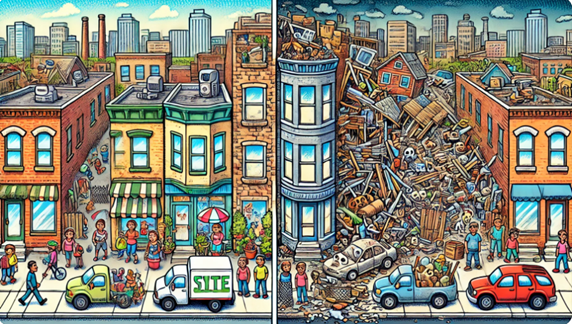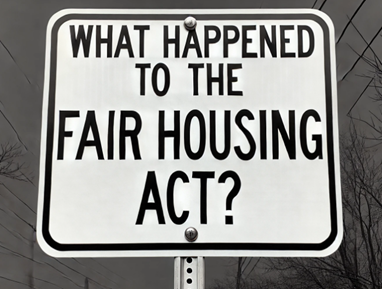Myth 2 - Any segregation in housing that Blacks may experience is strictly individual choice
Did you ever wonder—as I did for several decades—why so many African Americans throughout our nation live in neighborhoods lacking in amenities, opportunity, and investment? As a young adult, I would say to myself, “It’s so bad; why don’t they just leave?” If it were only that simple.
I didn’t realize until I was much older the historical context and systemic policies that have perpetuated residential segregation and marginalized Black communities for well more than 100 years.
Residential segregation by race had no legal framework immediately after the Civil War. Obviously, though, Whites had no desire to live with Blacks in the South, where well over 90% of Blacks lived until the early 20th century—unless they were sharecropping on White farms. However, even in the North in the late 1800s, both formal and informal policies ensured that Blacks could not live near Whites. Read the history of ‘sundown’ towns throughout the nation that would ensure in many places that Blacks could not even stay within town boundaries after dark.
 The 20th century brought us restrictive covenants (Whites were not allowed to sell to Blacks), housing and land-use restrictions, and redlining (the feds and the banking industry wouldn’t allow lending in Black neighborhoods); all these actions—and more—led to White city leaders across the country intentionally creating the Black ghettos we still see in small to large cities across the nation. Effectively, Blacks were not allowed to live anywhere but in these ghettos for much of the 20th century.
The 20th century brought us restrictive covenants (Whites were not allowed to sell to Blacks), housing and land-use restrictions, and redlining (the feds and the banking industry wouldn’t allow lending in Black neighborhoods); all these actions—and more—led to White city leaders across the country intentionally creating the Black ghettos we still see in small to large cities across the nation. Effectively, Blacks were not allowed to live anywhere but in these ghettos for much of the 20th century.
Why did White leaders and communities restrict Black people in these ways? It was their collective, reactionary attempt to neutralize The Great Migration, the mass movement of Black people escaping oppression and terrorism in the South to the North, Midwest, and West from 1910 to 1970.
Moreover, local and federal officials created public housing projects for Blacks from the 1930s to the 1970s within these already segregated African American neighborhoods. These ‘projects’ (often concrete block, Soviet-style buildings) intensified the poverty and isolation that already existed in inner-city neighborhoods and compounded the challenges already facing Black communities. The federal government halted the construction of these projects in the 1970s, and many have been torn down since then. Still, especially in Northeastern and Midwestern cities, too many of these buildings continue to ‘warehouse’ lower-income households today.
The nation’s post-World War II economic expansion primarily benefited White communities, with federal financing for housing development in the suburbs while excluding Blacks from those neighborhoods and disinvesting in the cities from which Whites were escaping. This disinvestment caused declines in already substandard housing conditions and more severely limited economic opportunities for Black families.
 For several decades (the 1950s-1970s), White federal and city leaders embarked on so-called ‘urban renewal’ (or what James Baldwin called ‘negro removal’) initiatives that disproportionately displaced Black families out of their neighborhoods and disrupted their communities without providing adequate rehousing or support to other areas of those declining cities.
For several decades (the 1950s-1970s), White federal and city leaders embarked on so-called ‘urban renewal’ (or what James Baldwin called ‘negro removal’) initiatives that disproportionately displaced Black families out of their neighborhoods and disrupted their communities without providing adequate rehousing or support to other areas of those declining cities.
I would have thought that when Congress passed the Housing Act of 1968, we would have seen a serious decline in racial residential segregation. Alas, nothing of the sort happened. Why?
“The Fair Housing Act [of 1968] was the most contentious of the civil rights-era legislation, blocked for years by Northern and Southern senators alike. It took infernos in more than 125 cities following King’s assassination to force the bill’s revival.”[i] The infernos refer to the racial uprisings across the nation, following the hundreds of uprisings that occurred in the three years before (1964-1967) in response to police brutality and profound economic discrimination and exclusion.
Although the new housing law banned racial discrimination, intimidation, and coercion of all types in the real estate industry, these practices continued near-unabated.
The Act also required the Housing and Urban Development Department (HUD) to affirmatively promote fair housing (AFFH), which has remained undefined since 1968. Although AFFH presumably enabled the government to help bring about more integrated neighborhoods, it has done nothing of the sort.
The Act should have allowed HUD to refuse funds to any city, county, or state applicant that didn’t demonstrate how they would ensure fair housing and certify that housing discrimination would not occur. Yet, in the first half-century of the Act, HUD delivered grants to 1,200 communities ($137 billion total) and only withheld funds twice.
Just consider that. Racist and discriminatory housing was legal until 1968, but in the decades after, HUD never found communities that had violated the law. We know the violations committed by cities, counties, and states had to be rampant. Very rarely did any residential integration occur as a result.
 In fairness, the Fair Housing Act limited HUD’s authority to enforce the act. Late in President Nixon’s first term, he wrote an internal White House memo that said that he was “convinced that while legal segregation is totally wrong that forced integration of housing or education is just as wrong. … I realize that this position will lead us to a situation in which blacks will continue to live for the most part in black neighborhoods and where there will be predominately black schools and predominately white schools.” [ii]
In fairness, the Fair Housing Act limited HUD’s authority to enforce the act. Late in President Nixon’s first term, he wrote an internal White House memo that said that he was “convinced that while legal segregation is totally wrong that forced integration of housing or education is just as wrong. … I realize that this position will lead us to a situation in which blacks will continue to live for the most part in black neighborhoods and where there will be predominately black schools and predominately white schools.” [ii]
Subsequent presidents (Carter, Reagan, Bush I and II, Clinton) followed suit, mainly because neither Democrats nor Republicans in Congress strongly opposed enforcement. So, the billions of dollars released to ensure integration were instead mostly used to leverage continued segregation.
Meanwhile, even after the Act became law, the Federal Housing Administration continued to pursue redlining policies that reinforced lending in White neighborhoods while often refusing to lend in Black neighborhoods.
From the late 1960s until 2000, many Black households still didn’t have the resources to buy suburban-style homes, and much of the housing produced for decades was single-family, detached housing in the suburbs. By the late 20th century, Blacks began to move into inner suburbs that Whites quickly fled, and lending institutions and developers largely refused to invest in those neighborhoods in the same way they did when Whites fled the cities to the inner suburbs in the first place.
The Community Reinvestment Act (CRA) of 1977 was enacted to ensure that banks did a far better job meeting the needs of neighborhoods in low- to moderate-income communities. Despite the CRA, by the early 1990s, the Federal Reserve discovered that Black and Brown “mortgage applicants were 60% more likely to be denied a mortgage loan with comparable qualifications.” [iii]
Not much has changed In the 21st century. Disparities in home loan approval rates and property tax assessments continue to burden people of color disproportionately. In contrast, discriminatory practices in home appraisals further contribute to the undervaluation of Black-owned homes. These practices further reinforce and perpetuate racial wealth gaps.
Additionally, predatory lenders (not governed by the CRA) prey on these Black and Brown neighborhoods because traditional banks offer little to no service. What does that look like? According to the Center for American Progress, 90 percent of the 1,800 bank branches closed in neighborhoods with lower incomes and higher poverty rates since the Great Recession.
You may remember that the subprime mortgage crisis of 2008 disproportionately affected Black homeowners, leading to significant wealth losses and foreclosures, particularly in communities of color.
 All these reasons—and more—are why so many American neighborhoods remain segregated by race. Decades of research consistently link residential segregation to a myriad of racial inequalities, including disparities in employment, health, and education, underscoring the human cost of this policy failure.[iv]
All these reasons—and more—are why so many American neighborhoods remain segregated by race. Decades of research consistently link residential segregation to a myriad of racial inequalities, including disparities in employment, health, and education, underscoring the human cost of this policy failure.[iv]
As a result of this exasperating recent history, here’s where we’ve currently landed as a nation:
- The gap between White and Black homeownership has grown, believe it or not, from a gap of 27 percentage points to 30 over the past 55 years.
- Black residents are almost three times more likely to live in an area with low vehicle ownership and low transit access.
- Black Americans earning $75,000 per year typically live in poorer neighborhoods than White Americans earning $40,000 per year.
- For Blacks and Whites living in comparable homes and neighborhoods, a Black home, on average, is valued at $48,000 less than a White home. As neighborhoods become more expensive, the gap in value grows more significant still.
- Bank lenders are 80% more likely to reject similar Black and White applicants for bank loans and mortgages.
- Neighborhoods where 90% of Blacks live are taxed 50% higher than neighborhoods that are majority White … in the same county.
All of this demonstrates a deep-rooted reluctance by our nation—and frankly by mainly White policymakers and White leaders in the private sector (think bankers and developers)—to challenge entrenched racial segregation.
Thus, the enduring legacy of racial segregation in housing emphasizes the need for comprehensive structural reforms to address systemic inequalities and promote inclusive communities.
Until we move beyond the myth that segregation results solely from individual choices, we will not overcome the historical legacy of systemic racism and the ongoing disparities faced by Black Americans about where they can and do live.
Images courtesy of ChatGPT.
[i] Nikole Hannah-Jones, “Living Apart: How the Government Betrayed a Landmark Civil Rights Law,” ProPublica, June 25, 2015, https://www.propublica.org/article/living-apart-how-the-government-betrayed-a-landmark-civil-rights-law.
[ii] Ibid.
[iii] Dubravka Ritter, “Do We Still Need the Equal Credit Opportunity Act,” Reserve Bank of Philadelphia, September 2012, p. 24, https://papers.ssrn.com/sol3/papers.cfm?abstract_id=2154865.
[iv] Hannah-Jones.

